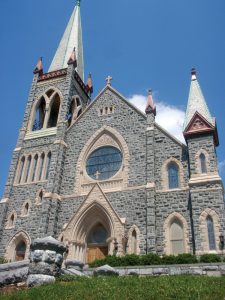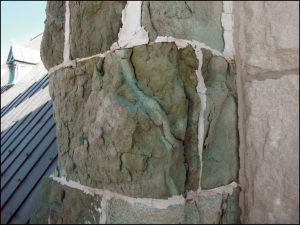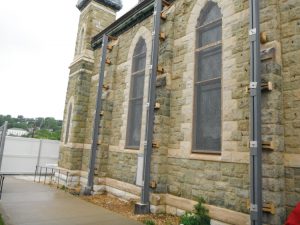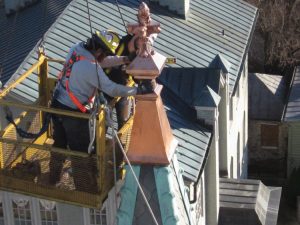19th Century Stone Church Receives New Façade
The deterioration of the masonry façade at St. Francis of Assisi Catholic Church, an English Gothic-style structure originally constructed in 1895 and located in Staunton, Virginia, presented a life-safety issue for parishioners and necessitated the evaluation of the historic structure. Significant water infiltration, cracking, and spalling of the original greenstone façade had progressed to the point that overhead protection was installed to serve as a shield against falling debris. Cracking and staining of the limestone elements and missing copper elements also contributed to the life-safety concerns, as well as diminished the aesthetic appearance of the church. While previous restoration efforts to address ongoing issues had been conducted, such as repointing and replacement of the stone in the bell tower with bluestone, the problems persisted. In 2012, WDP & Associates (WDP) was retained to provide an evaluation of the façade and to develop a comprehensive repair and restoration program.
The field investigation revealed that the original construction of the walls, from exterior to interior, consisted of six- to eight-inch thick blocks of Pennsylvania ashlar greenstone, or serpentine stone, followed by a rubble masonry infill and two full wythes of brick masonry. The window surrounds were comprised of limestone, which was also employed at capstones and other decorative pieces. Copper elements appear on the church structure as well, most noticeably on the bell tower. Generally, the limestone was in good condition, but the serpentine stone had experienced significant distress.
Balancing Safety with Historic Integrity
From the beginning, the parish’s primary objective was to ensure that the design would fully resolve the problems while remaining true to the historic integrity of the building. Additionally, the execution of the work could not interfere with the daily parish activities or impact the nave’s interior finishes. A successful restoration would provide a safe, reliable structure which would serve the parish for another 100 years.
Several restoration methods were evaluated, including consolidation treatments or using cast concrete to match the existing greenstone as outlined in historic preservation briefs. However, neither of these methods met the parish’s long-term criteria, as the serpentine stone is typically not a good candidate for consolidation treatments and the stone deterioration was far too extensive and widespread.
Replicating the Façade with Granite
Ultimately, the parish decided on a comprehensive overhaul of the entire exterior wall system. The existing greenstone and rubble masonry would be removed, the remaining brick would be repointed, and a new brick wythe and grouted collar joint would be installed behind new four-inch-thick granite stone. To ensure full integration of the new components with the existing limestone to remain, the pointing of the new granite coincided with repointing of the limestone.
The design accounted for the original look of the building, a concern of the local historic preservation council as well as the parish, by utilizing light imaging, detection, and ranging, or LiDAR. Scans of the existing church elevation were collected to ascertain the exact dimensions of every existing green serpentine stone and replicate them with mountain green granite stone. Extensive shop drawings assigned a unique number to every stone used in the wall. Each new granite stone matched the dimensions of the original serpentine with the exception of thickness to avoid additional loading on the foundation walls. The new stone was palletized and shipped to the site by section number, and each section was laid out to check carefully for fit and dimension. Using granite stone rather than cast concrete provided a more durable façade while staying true to the traditional masonry construction methods. The laser scans ensured that the overall look of the church would not be changed, as the same stone pattern was precisely replicated.
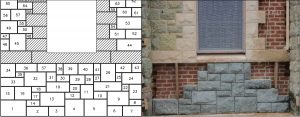
Granite shop drawing and field layup – each granite element is assigned a unique identification number.
Installation Challenges
Removal of over half of the original wall thickness for the performance of the extensive repairs, without disruption of services, posed an installation challenge. A unique phasing plan and temporary external strengthening measures were developed to circumvent these challenges. External supports, consisting of steel columns anchored through the exterior stone masonry, were installed at the buttress locations. WDP performed a structural analysis to determine the maximum area of the wall that could be removed without compromising the overall stability of the structure. The results of the analysis dictated the phasing plan; small sections of stone and inner brick wythe were removed at a time, followed by repointing and installation of materials, including glass fiber reinforced polymer (GFRP) bars at areas of high tensile stresses, before proceeding to the next section. GFRP bars were selected for their high tensile capacity, small diameter, and the longevity provided by not being susceptible to corrosion. The external strengthening was removed at the completion of infill walls, and a similar sequence then occurred at alternating buttress locations. In using these methods, the exterior walls retained enough stability to resist out of plane loads and support the roof structure, even while over half of the overall wall thickness was removed.
The restoration plan also called for close replications of the mortar and the brick replacement. Through testing at the investigative phase and several rounds of submittals and mockups, a replacement mortar was designed to replicate the original mortar properties, aggregate color, and gradation. Additionally, the new brick wythe consisted of hand-molded brick carefully selected to match the properties of the original brick and was joined with existing wythes using traditional header courses.
Due to the reduction of stone thickness between the original serpentine and the replacement granite, GFRP bars were incorporated into the walls at locations of high tensile stress. The GFRP was chosen over conventional reinforcing steel due to its high tensile capacity, better strain compatibility, small diameter, and longevity due to its insusceptibility to corrosion.
Various copper elements of the original structure had either deteriorated or fallen off the church entirely, including the copper spires of the bell tower which had been replaced with cast stone. As part of the restoration project, the original architectural details and the removed samples of intricate copper pieces were used to reconstruct replica copper details. Some of the more intricate pieces were handmade in Germany. Dentil courses, spires, and decorative elements were replicated to match the original church construction.
Accessing the structure presented its own challenges, as no construction loads could be placed on the roof. Extensive scaffolding was designed and installed to be cantilevered around the bell tower. Fencing and overhead protection safeguarded parishioners as the church continued its services.
Over its 100-plus years of service, the limestone had incurred staining from various elements. Cleaning and restoration of these elements provided a fresh look to match the other façade renewal. Other restoration activities performed included: re-anchorage of coping stones using stainless steel anchors; installation of new copper flashings; replacement of the cedar ceiling at the bell tower; waterproofing of the bell tower; restoration of the wooden window trim and louvers; restoration of the decorative metal railings; and the replacement of damaged slate shingles.
Rededication
After fourteen months of restoration with no disruption of services, the entire construction program was completed and the church celebrated with a rededication of the building on May 8, 2016. The façade reconstruction of St. Francis of Assisi Catholic Church provides an example of how to blend traditional restoration methods, such as matching traditional mortars and brick and the use of handmade replicas of the decorative copper elements, with new technology in the form of laser scanning, temporary strengthening, GFRP reinforcing, and complex access scaffolding. Using the best of old and new methods allowed the team to improve and restore this 100-plus-year-old façade, helping to ensure that it will remain an important gathering place for another century to come.▪
Project Team
Owner: Catholic Diocese of Richmond, VA
Engineer: WDP & Associates, Consulting Engineers, Manassas, VA
General Contractor: Lantz Construction Company, Broadway, VA
Stone Mason: Rugo Stone, Lorton, VA
Granite Supplier: ColdSpring, Cold Spring, MN
Copper: The Durable Restoration Company, Columbus, OH

